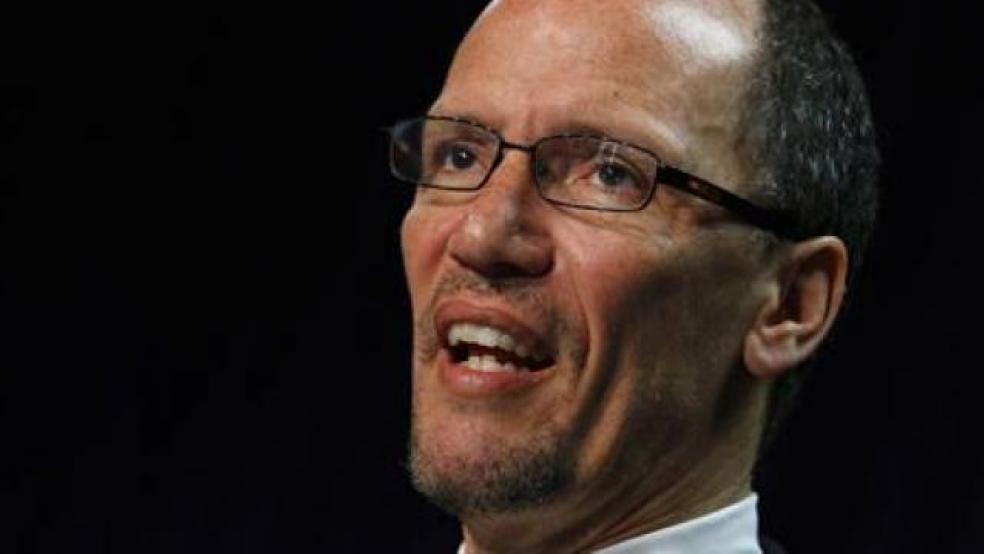In the boom-and-bust cycle of American political parties, the Democrats are at what can only be seen as the nadir of a bust. Completely shut out of power in the nation’s capital, and facing greatly diminished influence in state government, the party has spent the three and a half months since the wipeout of the November elections in an internal debate about how to move forward.
Over the weekend, the first tentative answer to that question came with the election of former Labor Secretary Tom Perez to chair the Democratic National Committee. The party, despite broad repudiation at the polls in November, has decided not to stray too far from its current ideological orientation. A majority of the voting members of the DNC rejected a more leftward direction embodied by Minnesota Congressman Keith Ellison, who came in second in the balloting.
Related: The Deep Current of Fear at CPAC Turns to Palpable Paranoia
Perez is closely associated with Hillary Clinton, who lost the presidential election to Donald Trump in November, and for that reason was seen by some as too closely tied to a leadership structure that failed the party in 2016.
On Sunday, in appearances on multiple talk shows, Perez admitted that the party had failed to reach as broad an audience as it needed to in the election, and said he would pursue a new strategy of local engagement, promising to be active in “every ZIP code.”
“We have to rebuild our party in the 50 states and territories and that’s exactly what we are going to do,” he told Chuck Todd on NBC’s Meet the Press. “We also have to redefine our mission. We not only elect the President of the United States, but we elect people from the school board to the Senate and everywhere in between.”
On ABC’s This Week, he promised to “build strong capacity to elect Democrats up and down the ticket.”
Related: A First for Obamacare: Majority of Americans Now Support It
It was more of the same on CNN: “We have to make sure we’re out there everywhere talking about how we’re the party of good job creation, the party of middle-class security, we’re the party of inclusion. we believe our diversity is our greatest strength. When we lead with these values I believe we succeed.”
If the promise to make the Democrats compete everywhere in the country sounds familiar, it should. In 2005, after George W. Bush was reelected to the presidency and Republicans solidified their hold on both the House and the Senate, a demoralized party turned to Howard Dean, the former Vermont governor, whose “50-State” strategy helped the party rebound, taking control of both Houses of Congress in 2006 and the White House in 2008.
In his first move as DNC chair, Perez reached out to Ellison, who accepted the offer to serve as Deputy Chairman of the group. They publicly embraced on stage at the party gathering in Atlanta in an effort to show that any difference had been put aside.
After President Trump used Twitter to attack the DNC leadership race as “rigged” -- a tactic he used during the Democratic primary to try to aggravate the dissension between Clinton supporters and those backing Vermont Sen. Bernie Sanders, Perez shot back:
Related: Americans Sour on Trump and Congress as Replacing Obamacare Flounders
“Our unity as a party is our greatest strength, and it’s his worst nightmare.”
But just how unified the party really is remains to be seen. In an interview on CNN Sunday Sanders, whose strong primary performance has made him a major power broker in the party despite his status as a registered Independent, was notably cautious in his statements about Perez. He had been a vociferous Ellison backer before the election.
“Right now Tom Perez has a real opportunity in his hands and I hope he seizes it,” he said. “And that is to understand that, in fact, the way the Democratic party has been run for decades has not worked. We need a total transformation.
“We have to open up the party to working people, to young people, and make it crystal clear that the Democratic Party is going to take on Wall Street it’s going to take on the greed of the pharmaceutical industry, it’s going to take on corporate America that is shutting down plants in this country and moving our jobs abroad abroad.”
Related: Why a Small Interest Rate Hike Means a $50 Billion Hit to the Federal Budget
He pointed out that he had attended a rally of 5,000 people in heavily Republican Kansas on Saturday, and that there had been 150 other Democratic rallies across the country that same day. The job of the DNC, he said, “is to motivate the grassroots.”
However, when Sanders was asked by Jake Tapper if he would share his massive database of supporter emails and other information gathered during his campaign, he waffled. In the end, he left the impression that he would be making decisions on which Democratic candidates to support on an individual basis, rather than handing over his supporter list to the DNC wholesale.
The implication is that he is concerned Perez will turn out to be more of the same thing the Democratic establishment has been offering for the past eight years.
And if that is Sanders’ worry, it’s also Republicans’ hope. In an interview on Fox News Sunday, former Trump campaign manager and occasional surrogate Corey Lewandowski called Perez’s election, “More of the same from the Democratic Party, which is what caused them to lose the presidential election





